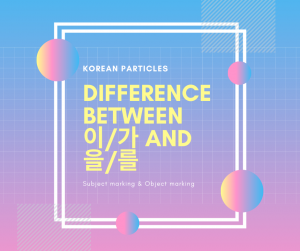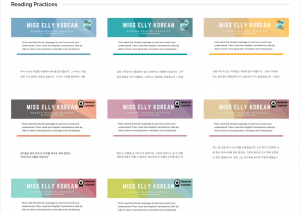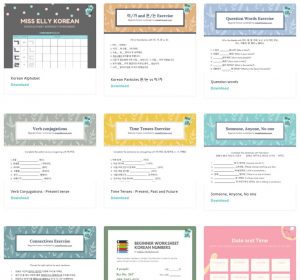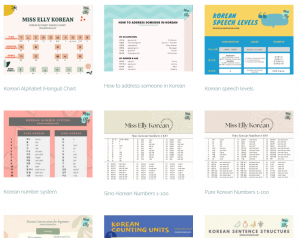
In this post I will explain the difference between the Korean particles 이/가 and 을/를. Particles is a concept that does not exist in English, so Korean learners with English as native language will easily find this concept confusing. However, they have very good reason to exist and play an important role in Korean sentences due to the different structure as compared with English.
We call 이/가 and 을/를 particles but what is meant by particles? They are functional words to indicate the role or location of a noun. They come directly after the noun they describe. For example:
제가 사과를 먹었어요.
I ate an apple.
In this sentence, 가 describes the 제 in front of it, while 를 describes the 사과 that comes directly in front of it.
Now we come to what exactly do 이/가 and 을/를 say about the word they try to describe.
이/가 are subject marking particles, meaning that the noun comes in front of it is the subject of the sentence and the performer of the action.
을/를 are object marking particles, meaning that the noun that comes in front of it is the object of the sentence and the receiver of the action.
The above example illustrates clearly that ‘I’ was the subject who performed the eating action while the ‘apple’ was the object being eaten.
You will notice that especially in daily speech, subject or object marking particles are not always used in all instances. In order to shorten the sentences for everyday speech, Koreans will drop these particles if the meaning is clear even without them. For example
선물(을) 샀어요.
I bought a gift.
In this example, even without 을 it is clear that the gift is the object that is being bought, therefore it is okay to drop the object marking particle.
Note that 을 and 이are used when the noun in front of it ends with a consonant (선물을, 책이), while 를 and 가 are used when the noun in front ends with a vowel (사과를, 고양이가). This is for the ease of pronunciation. When a noun ends with a consonant, that consonant will carry forward to the 이 because 이starts with a vowel, i.e. 선물을 is pronounced like 선무를 while 책이 is pronounced like 채기. On the other hand when a noun ends with a vowel, 가 which begins with a consonant comes after it. This will avoid the need to pronounce two consecutive consonants or two consecutive vowels which can be a bit awkward sometimes. Imagine it is hard to pronounce ‘책를’ quickly.
I have mentioned that 이/가 and 을/를 play an important role in the Korean language. This is because in Korean, the verb or adjective always comes at the end of the sentence as you see from the above example:
제가 (I) 사과를(Apple) 먹었어요(ate).
Therefore both the subject and the object of the action come before the verb. To make things more confusing, it is very common in Korean to drop either the subject, the object or both the subject and the object in the sentence. For example:
밥을 먹었어요.
I ate rice. (The subject ‘I’ was dropped)
누가 지갑을 찾았어요?
제가 찾았어요.
Who found the wallet?
I found it. (The object ‘it’ was dropped)
사랑해요.
I love you. (Both the subject ‘I’ and object ‘you’ were dropped)
Unlike in English, where the subject and the object roles are clear from the position in the sentence in relation to the verb:
Subject – verb – object.
and it is not permissible to drop either the subject or the object for a transitive verb. Now you see why in Korean, subject marking 이/가 and object marking 을/를 are necessities.
Apart from 이/가 and 을/를, there are also the closely related topic marking particles 은/는 which have overlapping usages with 이/가. I have another post discussing their difference in usage.
If you find this post useful, subscribe to read more of these grammar points explanation and Korean learning techniques. If you want me to talk about any specific topics feel free to leave a comment below. Have fun learning Korean!
Want to practice Korean particle usage with worksheets? Check out our PDF Marketplace!
Our Beginner Worksheet Pack has grammar worksheets, reading practices, grammar cheatsheets and exclusive posts on study strategies, all tailored for the beginner level.



0 Comments